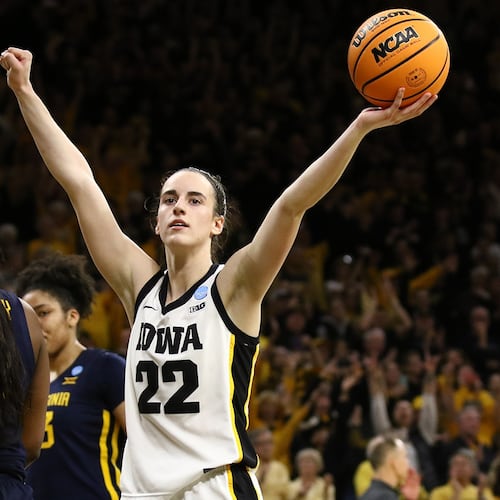This will be about Villanova, which plays Michigan for the national championship here Monday night. First, though, some context.
The 3-point shot is no new deal. The NCAA adopted it in 1986. The first Final Four in which a 20-footer was worth three points featured Providence, with Rick Pitino as designer and Billy Donovan as implementer, and UNLV, which hit 13 treys against Indiana, a record that held until Saturday night. Freddie Banks, who made 10 of the 13, said afterward: “Yes, my shooting was tremendous tonight.”
Over the intervening three decades, collegiate teams haven’t exactly backed away from the trey. In a realm where good big men tend to spend no longer than six months on campus, it has assumed even greater power. Lessons taken from college – drive-and-kick, pace-and-space – can be seen in the NBA. It works the other way, too.
Speaking Sunday, Villanova coach Jay Wright said: “We always look at what the NBA is doing. The Golden State Warriors have been using this for a while. Mike D’Antoni’s Phoenix teams had a great influence on us. In fact, Jalen’s favorite player was Steve Nash.” (Point guard Jalen Brunson is the national player of the year.)
Villanova has long been one of the prime exponents of the trey. Two years ago, Kris Jenkins’ 3-pointer at the horn beat North Carolina in the NCAA final. But what the Wildcats did to Kansas, a fellow No. 1 seed, here Saturday seemed an instance of the commonplace being lifted to a rarefied plane.
Of Villanova’s first 15 baskets, 13 were 3-pointers. Bill Self called his first timeout not three minutes in, his Jayhawks already down 9-2. He called his second with 13:03 remaining in the first half, his team now 18 points in arrears. He switched defenses and saw the Wildcats, who’d shredded his man-to-man for four treys and a deuce over five possessions, make four treys in a row over a zone.
Said Self: “They got anything they wanted early … We got spread out and our game plan went to crap on how we were going to guard certain actions. Then we got caught in between, and the worst thing you can do defensively is be caught in between.”
Villanova would win 95-79. It made 18 treys, obliterating the Final Four record by five. Said Wright: “Man, we made every shot to start the game.”
But it wasn’t just to start this game, and it wasn’t as if Villanova hasn’t been doing something similar all along. With the 18 treys, the Wildcats ran their seasonal total of 3-pointers to 454, most ever by a Division I team.
Wright has run a motion offense since his days at Hofstra, where big men were in short supply. His 2005-2006 Villanova team lost so many bigs to injury that he was forced to start four guards. (Mike Nardi, now the Wildcats’ director of basketball operations, was one of the four. Kyle Lowry, an NBA All-Star for Toronto, was another.) That team went 28-5 and was a No. 1 seed in the NCAA tournament; it was eliminated in the Elite Eight by Florida, which had Al Horford and Joakim Noah and was just too big.
Wright no longer deploys four guards – it’s just that his big men shoot like guards. Self said he’d asked Bob Huggins, whose West Virginia Mountaineers had been run down by Villanova in the Sweet 16, for advice. Huggins’ discouraging text: “You’d better hope (center Omari) Spellman doesn’t shoot the ball well.”
Spellman, who’s 6-foot-9 and 245 pounds, made three treys against Kansas. Forward Eric Paschall, who’s 6-9 and 250, made four. This was not by accident. Having big men who can shoot, Wright said, “is invaluable. It’s the toughest thing to guard.”
Villanova's standard set is called "four out, one in." (A handy breakdown can be found on coachbase.com.) There's always a post player, whose presence in the lane is offset by the other big man -- known as the "slot big" -- flaring to the perimeter. (Ergo, the "four out.") The Wildcats station two guards high and run the usual ball screens and pick-and-rolls. There's nothing terribly revolutionary about that: Villanova just does it better than anybody else.
Wright has long put a premium on shooters, to whom he imparts a golden rule: You’re never more open than when you catch the ball. When you’ve stocked up on shooting and your shooters aren’t afraid to miss, you can put up big numbers. The 18 treys against Kansas didn’t constitute a Wildcats season high. Villanova’s shooting is tremendous most nights.
It also helps that Wright’s recruits stick around. “We can’t get the one-and-dones,” he said, but that has become more asset than debit. All the Wildcats know the system. All of them can make a jump shot. That they run their halfcourt sets at fast-break speed is a function of knowing where to go because they’ve gone there many times.
As for Michigan: Yes, the Wolverines have a chance. They're the Big Ten champ. They haven't lost since Feb. 6. Villanova, which isn't a great defensive team, will have trouble with Moritz Wagner. John Beilein knows Wright and Villanova well from his days in the Big East with West Virginia. According to Ken Pomeroy's rankings, Michigan is third nationally in defensive efficiency.
But Villanova is No. 1 in offensive efficiency, and the margin between the Wildcats the the No. 2 team is 4.9 percentage points. (The margin between No. 2 and No. 15 is 4.7.) This is only the fifth team since the tournament expanded in 1985 to reach the final while winning every game by at least 10 points. The only one of the previous four not to claim a title was North Carolina in 2016. It lost to Villanova. On a 3-point shot.
About the Author
The Latest
Featured


